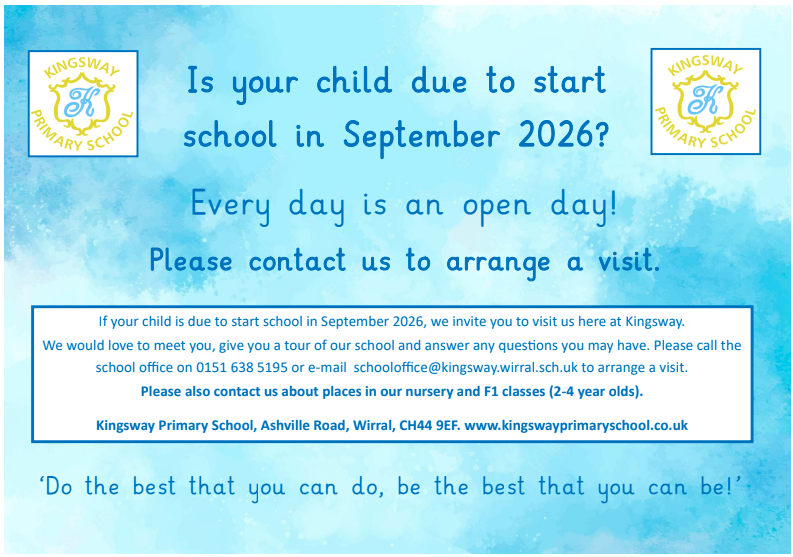Read Write Inc. and Phonics

.png)


A Parents’ Guide to Read Write Inc. Phonics.
At Kingsway Primary School, we use the Read Write Inc. (RWI) programme to get children off to a flying start with their literacy.
Read Write Inc. Phonics is a method of teaching reading and writing, which is centred around learning the sounds of the letters (phonics) and then blending them together to read words. The children also learn to break down words into individual sounds in order to write them.
When using RWI to read the children will:
- Learn to read effortlessly so that they can put all their energy into understanding what they
- Learn 44 sounds and the corresponding letter/letter groups using simple picture
- Learn to read words using Fred
- Learn to read words by blending the sounds
- Read lively stories featuring words they have learnt to sound
- Show that they understand the stories by answering 'Find It' and 'Prove it' discussion
When using RWI to write the children will:
- Spell effortlessly so that they can put their energy into working out what they want to
- Learn to write the letters/letter groups which represent the 44 sounds (graphemes).
- Learn to write words by saying the sounds in Fred
- Learn to write simple and then increasingly complex
- Compose a range of texts using discussion
- Compose stories based on picture
- Write simple
Blending
Children learn to read words by blending the letter sounds that are in the Speed Sound sets. Help your child learn to read words by sound-blending e.g. c-a-t = cat. Help children to say the pure sounds, as quickly as they can and then to blend the sounds together to say the whole word.
How will I know how to pronounce the phonic sounds?
http://www.ruthmiskin.com/en/parents/
The Phonics Screening Check
The phonics screening check is a government strategy to complete a quick and easy check of your child’s phonic knowledge at the end of Year 1.
How does the check work?
· Your child will sit with his/her teacher and be asked to read 40 words aloud.
· Your child may have read some words before and others may be completely new.
· The check normally takes a few minutes to complete and there is no time limit.
What are ‘non-words’?
The check will contain a mix of real words and ‘non-words’.
You may hear your child describe them as nonsense or alien words as they are very familiar with these during phonics sessions.
Non-words are important to include because words such as ‘vap’ or ‘jound’ are new to all children. They cannot read the non-words by using their memory or vocabulary so they have to use their decoding skills and this allows teachers to check their ability to decode.
After the check
School will let you know about how your child had done in the screening check at the end of the summer term. Children who have not met the standard in Year 1 will have the opportunity to retake the check in Year 2. School will also let you know what support will be put into place to support your child.
Helping your child with phonics and reading at home
Phonics works best when children are given plenty of encouragement and learn to enjoy reading and books.
Parents play a very important part in this and there are lots of ways you can help.
- ENCOURAGE YOUR CHILD TO JOIN IN AND DO THE ACTIONS. THIS CAN BE DONE WALKING HOME FROM SCHOOL, DRIVING THE CAR OR WASHING THE DISHES!
- SING SONGS AND NURSERY RHYMES AT HOME TOGETHER.
- READ SOMETHING WITH YOUR CHILD – IT DOESN’T NEED TO BE A BOOK! COMICS, MAGAZINES, FOOTBALL PROGRAMMES, TEXTS, EMAILS OR A CATALOGUE ARE A GREAT ALTERNATIVE.
- MAKE TIME FOR YOUR CHILD TO READ EVERY DAY. WE KNOW HOW BUSY IT CAN BE AT HOME SO REMEMBER GRANDPARENTS AND OLDER BROTHERS OR SISTERS CAN HELP TOO!
- WORD GAMES LIKE ‘I-SPY’ CAN ALSO BE A FANTASTIC WAY OF TEACHING CHILDREN ABOUT SOUNDS AND LETTERS. YOU CAN ALSO ENCOURAGE YOUR CHILD TO READ THE SHOPPING LIST OR ROAD SIGNS WHEN YOU’RE OUT IN THE CAR.
- TALK ABOUT WHAT THEY ARE READING. TALK BEFORE YOU START, TALK WHILST YOU ARE READING AND TALK AFTER YOU HAVE FINISHED. TALK, TALK TALK!
Book Talk
After reading it may be useful to ask your child some questions or have a ‘book talk’. Book talk is a really useful way of seeing how much the children have understood when reading.
Here are some examples of questions you could ask before, during and after reading.
Before
· Can you point to the title?
· What do you think this story will be about?
· What does the blurb/writing on the back tell us?
During
· What is happening in the pictures?
· What has happened so far? Is it what you expected to happen?
· What might happen next? How will it end?
· What sort of character is ___? Are he/she friendly/mean/nice, etc?
After
· Did you like the book? Why? (Encourage children to develop an opinion and explain their reason)
· What was your favourite part? Why?
· What was the most interesting/exciting/scary part?
Can you find it?
· What sort of character was___?
· What happened in the story?
· What did that character do ___ (give a situation or event from the story)
Useful Phonics Websites
There are lots of websites that can give you more information or some games to play with your child.
Have a look at the following:
www.bbc.co.uk/schools/wordsandpictures
www.teachyourmonstertoread.com
www.bbc.co.uk/cbeebies (especially the Alphablocks programmes and games)
www.mrthorne.com (lots of games and videos to show how sounds are pronounced)
Useful APPs
APPs are also a fantastic way to get children learning Phonics.

 Kingsway Primary School
Kingsway Primary School